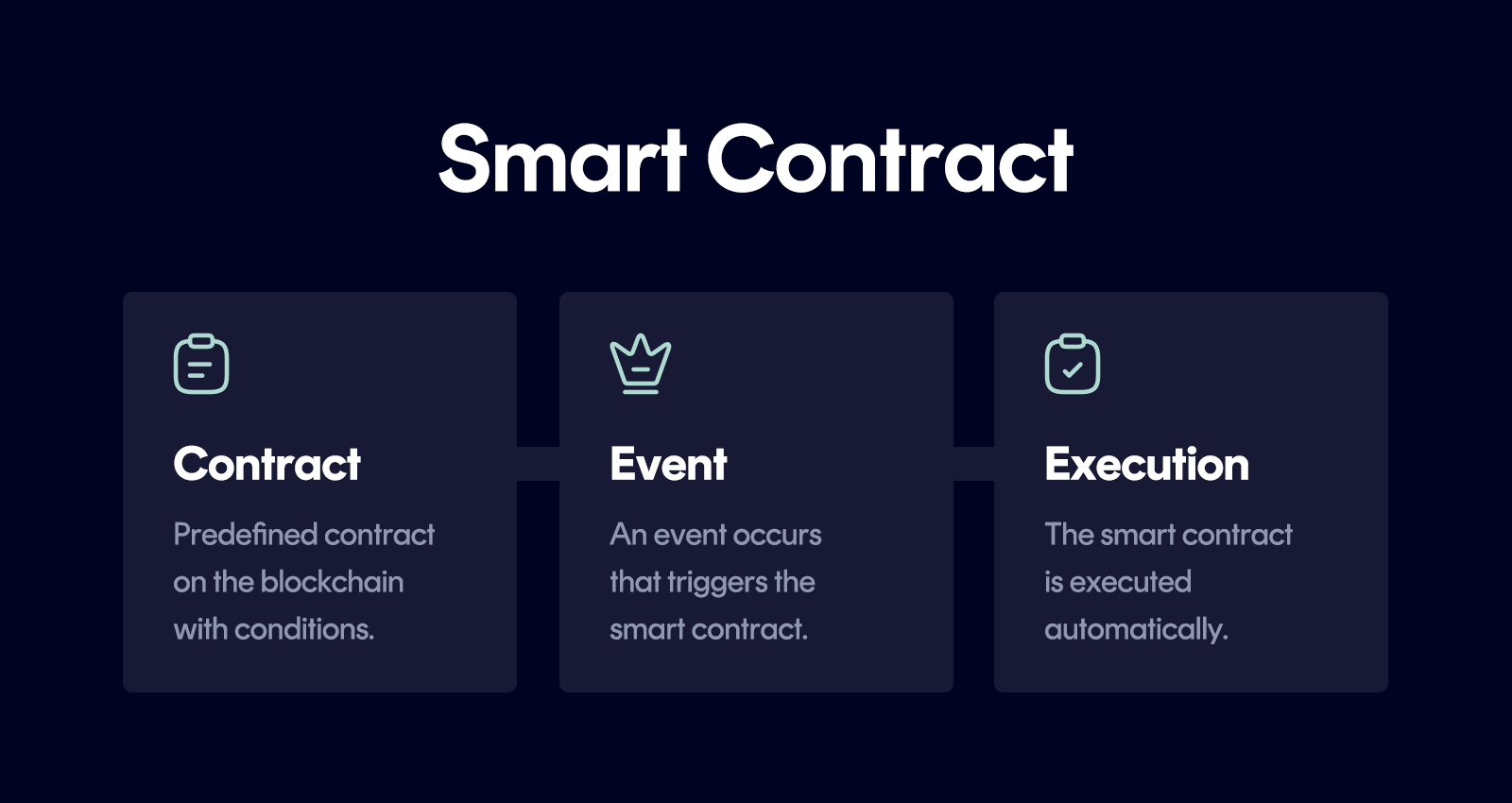What is Ethereum?
Ethereum is the second-largest cryptocurrency by market capitalization, second only to Bitcoin. While Bitcoin primarily serves as digital currency and "digital gold," Ethereum was designed from the ground up as a programmable blockchain - a platform for decentralized applications (dApps) that goes far beyond simple financial transactions.
Put simply, Ethereum is much more than just digital money. It's a global computer in the form of a blockchain, powered by its own cryptocurrency, Ether (ETH).
Table of contents

The key difference: Ethereum doesn't just enable sending cryptocurrencies, but also executing complex programs called Smart Contracts. These self-executing contracts require no central authority or third party — no lawyer, no bank, no middleman. They run automatically once predetermined conditions are met.
One important limitation: Smart contracts can only process information that's available within the blockchain. External data sources (like weather data, sports results, stock prices) must be integrated through so-called Oracles - specialized services that securely bring real-world data into the blockchain. This creates new centralization points, as few Oracle providers like Chainlink dominate the market.
Ethereum is redefining the traditional internet model. Instead of relying on centralized servers owned by tech giants, data is distributed globally across nodes, publicly viewable and traceable. This ensures data integrity and makes Ethereum virtually tamper-proof, thereby aiming for a decentralized internet where users have more control over their data, digital contracts, and finances with reduced dependence on large corporations or intermediaries.
What is Ether (ETH)?
Ether (ETH) is Ethereum's native cryptocurrency. It plays a central role in the system, comparable to gasoline in a car:
ETH is required to execute transactions and run smart contracts
Network fees incurred are called "gas" and are paid in ETH
ETH also serves as a store of value, payment method, and staking token within the Ethereum ecosystem
Foundation for other tokens: The Ethereum blockchain provides the basis for countless other cryptocurrencies (ERC-20 tokens)
That makes Ether more than just a traditional cryptocurrency — it's the essential fuel powering the entire Ethereum ecosystem.
How does Ethereum work technically?
Ethereum differs technically from Bitcoin primarily through its smart contracts and the Ethereum Virtual Machine (EVM).

The Ethereum Virtual Machine (EVM)
The EVM can be understood as a global, decentralized computer distributed across thousands of nodes (computers). Each Ethereum node runs the EVM software and validates the same computations. This ensures that smart contract results are uniform and no manipulation occurs.
Why the EVM is so important: It ensures that smart contracts execute identically and trustworthily on all Ethereum nodes, regardless of who hosts the code. This unified execution environment makes Ethereum apps interoperable and allows different applications to communicate seamlessly.
The Gas system in detail
For this global computer to function, it needs "fuel" in the form of Gas:
Gas units: Each operation in the EVM costs a specific amount of "gas"
Gas price: Measured in "Gwei" (1 billion Gwei = 1 ETH)
Transaction speed: Higher gas prices lead to faster processing
Protection against abuse: Gas prevents infinite loops and spam transactions
Validator rewards: Paid fees reward network participants
Pro tip: During high network congestion, gas prices rise. Most wallets automatically calculate optimal gas fees and offer different speed tiers (slow/normal/fast).
Smart contracts explained simply
Smart contracts are programs that execute automatically once predefined conditions are met, without requiring an intermediary.

Example:
A developer programs a contract: "If person A sends 1 ETH to the contract's address, they automatically receive a digital ticket."
This contract runs on Ethereum. No one can stop, change, or censor it, provided it was correctly programmed.
Important to understand: Smart contracts are only as "intelligent" as their code. They don't "know" whether a ticket is genuine or valuable. They only execute the exact programmed conditions. Security and functionality therefore depend entirely on programming quality.
Thanks to smart contracts, Ethereum enables:
Decentralized exchanges (like Uniswap)
Blockchain games with true ownership of digital assets
Automated financial contracts without traditional banks
Digital identities without central management
Tokenization of assets (real estate, art, etc.)
The Ethereum Ecosystem
Ethereum has fostered a rich ecosystem that extends far beyond simple money transfers:

Decentralized Applications (dApps)
dApps are applications that run on the blockchain and aren't controlled by any single central entity. They're often open-source and resistant to censorship or failures, since no central server can be shut down.
Decentralized Finance (DeFi)
DeFi platforms enable traditional financial services on a purely peer-to-peer basis:
Earning interest without banks
Taking loans without credit checks
Trading decentrally without exchanges as intermediaries
Insurance through smart contracts
Ethereum is the leading platform for DeFi. Protocols like MakerDAO, Aave, and Uniswap form a kind of digital banking system with global reach.
Non-Fungible Tokens (NFTs)
NFTs are non-interchangeable tokens where each token is unique. They often serve as digital proof of ownership:
Digital art and collectibles
In-game assets in blockchain games
Music and videos with ownership proof
Virtual real estate in metaverse projects
Decentralized Autonomous Organizations (DAOs)
A DAO is an organization controlled by smart contracts rather than traditional hierarchies. Governance occurs through tokens: those who own DAO tokens can vote on proposals and participate in decisions.
Ethereum 2.0 and Proof-of-Stake
A milestone in Ethereum's development was the upgrade to Ethereum 2.0, often called "The Merge." In September 2022, the original blockchain was merged with a new Proof-of-Stake blockchain.

Why was the upgrade necessary?
Under the old Proof-of-Work mechanism, Ethereum hit limits:
Only ~15 transactions per second possible
High transaction costs during heavy usage
Enormous energy consumption from mining
How does Proof-of-Stake work?
Proof-of-Stake replaces energy-intensive mining with a more efficient process:
Validators instead of miners: Rather than many computers competing to solve complex puzzles, a validator is chosen to create the next block. Selection is based on how much Ether they've deposited as stake.
Staking in detail:
High barrier to entry: At least 32 ETH (about $75,000) required to become a validator
Technical requirements: Continuously running hardware and internet connection needed
Random selection: The more ETH staked, the higher the chance
Tasks: Transaction processing, block creation, network security
Rewards: Stakers receive ETH as rewards (currently about 4-6% annually)
Penalties: Misbehavior results in staked ETH being destroyed ("slashing"), such as when validators try to cheat the network or behave dishonestly
Liquid staking risks: Services like Lido are convenient but concentrate power among few providers, and received tokens aren't identical to ETH
What validators do:
Transaction processing: Verifying and confirming transactions
Block creation: Proposing new blocks for the blockchain
Network security: Participating in the consensus mechanism through the Beacon Chain
Data storage: Storing blockchain data and synchronizing with the network
The Beacon Chain:
The Beacon Chain is Ethereum's Proof-of-Stake organizational system. It coordinates validators, manages staking, and ensures all participants work synchronously. Validators propose new blocks while other validators vote on their validity.
Rewards and penalties:
Rewards are split between Block Proposers (who propose new blocks) and Attesters (who confirm blocks). For dishonest or harmful behavior, staked ETH is destroyed through "slashing." This ensures system security.
Benefits of Ethereum 2.0:
99% less energy consumption (from about 78 TWh/year to just a few MWh), compared to traditional payment systems like Visa
Improved security through economic incentives
Foundation for further scaling through future upgrades
Important limitation: The transition also strengthened centralization tendencies through large staking pools
Layer-2 solutions and scaling
Despite Ethereum 2.0, scalability remains a central issue. The solution is Layer-2 networks - secondary protocols that build on Ethereum to process more transactions.
How do Layer-2 solutions work?
Layer-2 solutions process transactions outside the main Ethereum chain and send only compressed results back. Think of them like express lanes alongside the main highway.
The two main types of rollups:
Optimistic Rollups (e.g., Arbitrum, Optimism):
"Optimistically" assume transactions are valid
Arbitrum can theoretically process up to ~40,000 transactions per second
Transaction costs of just a few cents
One-week window for fraud challenges
Zero-Knowledge Rollups (e.g., zkSync, StarkNet):
Generate cryptographic proofs for each transaction
Mathematically provable correctness without delays
More complex technology, but higher security
Success of Layer-2 solutions:
Rollups are essential to bringing Ethereum to the mainstream. Millions of users can execute transactions simultaneously without overloading the main network.
Today, billions of dollars in value are already secured on Layer-2 networks. Users can access Ethereum applications with drastically reduced costs while maintaining main chain security.
Use cases
DeFi (Decentralized Finance)
Decentralized financial services enable:
Lending platforms like Aave and Compound
Decentralized exchanges like Uniswap
Stablecoins like USDC and DAI
Automated trading strategies without traditional banks
ICOs (Initial Coin Offerings)
ICOs were an early and important Ethereum application. Projects sell tokens instead of traditional stocks to raise capital:
Similar to IPOs, but with tokens instead of shares
Enabled by smart contracts on the Ethereum blockchain
ERC-20 standard as technical foundation for most ICO tokens
Keep in mind: ICO tokens typically don't come with legal ownership rights like traditional shares
ICOs showed early potential of Ethereum as a fundraising platform, though more regulated approaches are preferred today.
Use cases across various industries:
Finance: Automated loans, insurance, derivatives, decentralized exchanges
Real estate: Asset tokenization, transparent land registries, rental contracts
Healthcare: Secure patient data, drug traceability, research databases
Logistics: Complete supply chain documentation, origin verification
Energy: Peer-to-peer energy trading, green certificates, smart grid management
Elections: Transparent, manipulation-proof voting and citizen participation
Identity management: Self-sovereign digital identities without central authorities
Cybersecurity: Decentralized certificate management and secure communication
IoT (Internet of Things): Secure device-to-device communication and automated payments
Insurance: Automated claims processing through smart contracts
Institutional adoption
2024 saw the first Ethereum ETFs launched, and many companies are experimenting with Ethereum for supply chain management and accounting.
Strengths and weaknesses
What makes Ethereum strong
Ethereum isn't the leading smart contract platform without reason. It excels primarily through several decisive factors:
The largest developer community in the crypto space forms the foundation of its success. Thousands of developers continuously work on an enormous ecosystem of tools, protocols, and frameworks. This community strength shows in its diversity: from DeFi protocols to NFT marketplaces to complex DAOs, most blockchain innovations historically first emerge on Ethereum.
The Ethereum Virtual Machine (EVM) has established itself as the de-facto standard. Many other blockchains (BSC, Avalanche, Polygon) are deliberately EVM-compatible, facilitating portability and interoperability. Developers can often deploy their smart contracts across various networks without major modifications, providing enormous advantages for project scaling.
The established network with billions in volume offers proven infrastructure that's been in real-world use for years. Unlike experimental blockchain projects, users and businesses can build on a tested foundation. Trust in the network's stability and security has developed through years of proven performance.
The transition to Proof-of-Stake in 2022 drastically reduced power consumption by over 99% compared to energy-intensive mining. This makes Ethereum not only more environmentally friendly but also more institutionally acceptable for companies with sustainability goals.
Especially for developers and platform operators, Ethereum remains attractive even when other networks sometimes lead in performance or user experience.
Technical and structural weaknesses
Despite its strengths, Ethereum also shows clear weaknesses. Transaction fees remain a serious problem during high usage. Costs of $50-100 per transaction are no longer uncommon. While Layer-2 solutions like Arbitrum or zkSync help drastically reduce costs, they bring their own risks: centralized operators (sequencers) often control transaction ordering, and complex bridges between networks have been hacked multiple times, causing billions in damages.
The technical architecture shows signs of age after nearly a decade. Ethereum has existed since 2015, and this "legacy code" complicates fundamental improvements. Some speak of a certain developer lock-in: the EVM is widely adopted but not necessarily the most modern or efficient solution. Fundamental architectural flaws are difficult to correct without destabilizing the entire ecosystem.
Strong competition becomes increasingly noticeable. Networks like Solana offer significantly higher transaction speeds, Avalanche excels with sub-second finality, and Polkadot focuses on seamless interoperability. These alternatives are often more user-friendly and cost-effective. Ethereum must increasingly convince through quality, not just network effects.
Risks and central criticisms
The most critically discussed issue is increasing centralization in the Ethereum ecosystem. Staking pool Lido now controls about a third of all staked ETH, a concerning concentration since theoretically just 33% is enough to disrupt block finalization. Similarly problematic is dependence on few infrastructure services: providers like Infura or Alchemy dominate the node services market, and their failure could paralyze large parts of the dApp ecosystem.
Security risks are omnipresent and often underestimated. Smart contracts can contain critical bugs. The 2016 DAO hack cost $60 million and led to the split into Ethereum and Ethereum Classic. Cross-chain bridges have been repeatedly hacked, with total damages exceeding $2 billion. This means that if users lose their wallet phrase or trust a fraudulent smart contract, they irreversibly lose their assets. No chargebacks, no goodwill. The "Code is Law" principle shows no mercy.
Regulatory vulnerabilities become increasingly apparent. The Tornado Cash case showed that even decentralized smart contracts can become targets of authorities. US agencies sanctioned the privacy mixer and even arrested a developer. MiCA regulation in the EU and ongoing debates about securities classification in the US create additional uncertainty. Ethereum operates in a tension field between technical innovation and regulatory compliance, a balancing act that will shape the project long-term.
Conclusion
Ethereum has established itself as one of the leading platforms for smart contracts and decentralized applications. With its large developer community, extensive ecosystem, and continuous technical development, Ethereum is well-positioned for the future but must assert itself in an increasingly competitive environment.
Why Ethereum remains important:
For users: Ethereum is the hub for most blockchain-based applications that go beyond simple payments. Thanks to Layer-2 solutions, millions of people can use Ethereum as practical infrastructure for global value transfers, DeFi services, or NFT trading.
For developers: Ethereum has the largest developer community in the blockchain sector, though this also leads to a certain lock-in effect. The EVM has established itself as the de-facto standard, but nearly a decade of legacy code has resulted in technical debt that complicates fundamental improvements.
Realistic assessment: While this interoperability and rich ecosystem make Ethereum attractive for developers, market leadership isn't guaranteed. Newer blockchains often offer better user experience, lower costs, and more modern architectures. Network effects alone may not suffice long-term.
The journey continues: Ethereum's potential will only fully reveal itself over time. Maybe through applications still being built today, or by overcoming the technical hurdles it faces today. For newcomers, Ethereum offers a fascinating glimpse into the possibilities of a decentralized, programmable future of the internet.
Frequently asked questions about Ethereum
What is the current price of Ethereum?
The current price of Ethereum is $3,200.92. Over the past 24 hours, the price is up 0.98%, with a trading volume of $56.04B. Ethereum is the 2nd largest cryptocurrency by market cap, currently at $386.35B.
Is it worth investing in Ethereum?
The price change of Ethereum (ETH) over one year is currently +2.58%, making Ethereum a good investment in hindsight. Whether this trend will continue in the future depends on many external factors such as supply and demand. Past price trends are no indicator of future performance.
Where can I buy Ethereum?
The best and most reputable crypto exchanges for buying Ethereum include ones such as Kraken and Coinbase. You can find more in our comparison of crypto exchanges.
Which Ethereum wallet is the best?
The best hardware wallets for Ethereum are Ledger Nano X, BitBox02 and Trezor Model T. In our opinion, the best software wallet for Ethereum is the Zengo app. You can find more in our comparison of crypto wallets.
What was the all-time high of Ethereum?
The Ethereum (ETH) cryptocurrency all-time high is $4,946.05. This price was reached on Aug 24, 2025. The current price is $3,200.92, a difference of -35.32% from the all-time high.
Who has invested in Ethereum?
Ethereum's early investors include institutional investors and venture capitalists (VCs) such as a16z Crypto, Galaxy Digital, Boost VC, Pantera Capital, Digital Currency Group, Paradigm.
How many Ethereum (ETH) are currently in circulation?
There are currently 120.7M Ethereum (ETH) in circulation. The total amount of ETH in circulation represents all coins and tokens that have already been distributed and are therefore held in the wallets of private individuals, companies or institutions.
What is the Total Value Locked (TVL) of Ethereum?
The Total Value Locked of Ethereum (ETH) is currently $73.07B. This value includes all assets locked on the blockchain or in DeFi protocols. With a market cap of $386.35B, this results in a ratio of market cap to TVL of 5.29.
How many active addresses (24h) does Ethereum have?
As of the last update, Ethereum had about 811,416 active addresses (24h) — the number of unique addresses that sent or received a transaction in a rolling 24-hour window (each address counted once). Note: addresses ≠ users (one person or an exchange can control many).
How many transactions per day are running on Ethereum?
Ethereum currently has an average of around 1.48M transactions per day. This key figure indicates how many network transactions have taken place on average per day in the last 3 months.